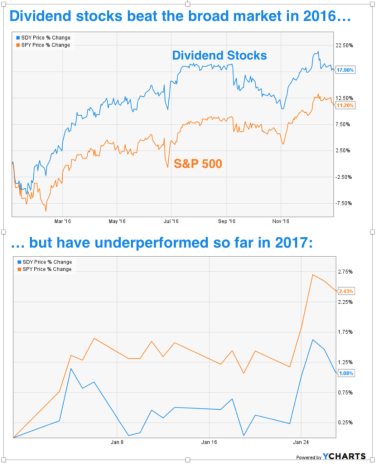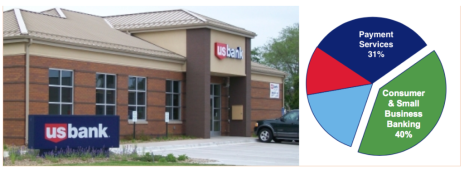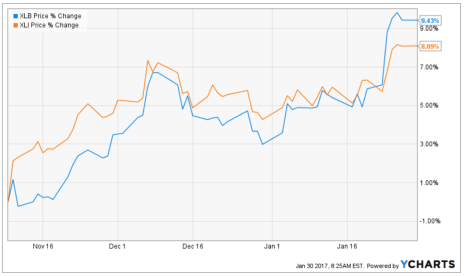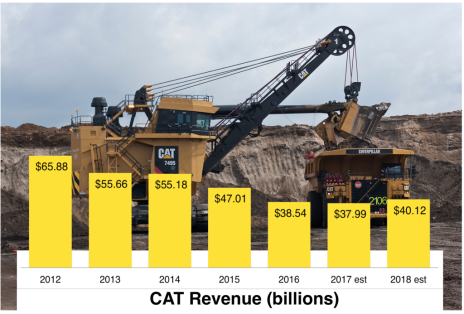Any list of the best dividend stocks for 2017 a month into the year has to start with this qualifier: dividend stocks have gotten off to an underwhelming start to the new year.
After trouncing their non-dividend-paying counterparts in 2016, dividend stocks have been underperforming the broad market since the start of 2017.
But over the long-term, dividend paying stocks consistently outperform their non-dividend paying counterparts. So dividend payers’ stumble so far in 2017 is a great buying opportunity!
This year, I expect the best dividend stocks to come from the following industries:
- Financial Stocks
- Industrials and Materials Stocks
- Energy Stocks
Bank stocks, insurance stocks and other financial stocks have had a great run since the election. Wall Street is hopeful that President Trump will repeal or revise some of the financial regulations passed in the wake of the 2008 financial crisis, including the Dodd-Frank bill. On top of that, interest rates are rising and the yield curve is getting steeper, both of which boost financial institutions’ profitability.
[text_ad]
Dividend stock investors have plenty of options to choose from in the financial sector; it’s one of the highest-yielding sectors in the S&P. In fact, you could just buy the Financial SPDR (XLF), which currently yields 2.6%.
Best Dividend Stock #1: U.S. Bancorp (USB)
But for investors looking for a combination of yield and growth potential, my favorite dividend payer from the financial sector is U.S. Bancorp (USB) stock.
Minneapolis, Minnesota-based U.S. Bank is a “super regional” bank. Forty percent of revenues still come from the bank’s Midwest-based consumer and small business banking branches. But U.S. Bank also provides national and international payment processing, wholesale banking and commercial real estate services. Approximately half of total revenue is now generated from fees for services like wealth management, payment processing and credit card servicing. This fee-based revenue is more reliable than income from investments, and largely insulated from market fluctuations.
U.S. Bank came through the financial crisis in much better shape than most banks, thanks to good management and the high average credit quality of its loan portfolio. At the height of the financial crisis, the company’s non-performing loan ratio was half the industry average. In the years since, the bank has increased its Tier 1 capital reserves, maintained the high credit quality of its debt portfolio and grown both shareholder equity and EPS every year.
Essentially, the only metrics on which performance has not improved every year since 2010 are U.S. Bancorp’s return on assets and net interest margin (NIM). Both of these reflect USB’s profitability, with NIM comparing the return on its investments to the interest the bank pays on its borrowings. Both have been depressed by historically low interest rates, which lower the returns available to USB on its investments and reserves.
But interest rates are starting to rise, and higher profitability for USB won’t be far behind. In the meantime, investors can collect a 2.1% yield thanks to USB’s reliable dividends, which the bank has paid since 1998 and increased every year since 2011.
Best Dividend Stock #2: Caterpillar (CAT)
Industrial stocks, materials stocks and stocks of companies that work on major infrastructure projects have also been on a tear since the U.S. election. In the past week, Donald Trump has cleared the way for two major oil pipelines, promised to build a wall along the U.S.-Mexico border and reiterated his pledge to reduce environmental regulation on U.S. industry.
Investors interested in benefiting from these moves have plenty of options. The Basic Materials SPDR (XLB) yields 2.4%, while the Industrials SPDR (XLI) yields 2.5%. Both have rallied strongly since the election.
For discerning investors, Caterpillar (CAT) is a great way to play the rebound in multiple heavy industries in a single stock.
Caterpillar makes heavy machinery and vehicles used in the construction, mining, energy and transportation industries. The company’s equipment is so ubiquitous that it’s hard to imagine an industrial, commodity or infrastructure boom it wouldn’t benefit from, from investments in American roads to higher production at South American mines to stronger demand for energy in China. Higher commodity and energy prices are also a tailwind, since they mean many of Caterpillar’s customers have more cash to invest.
Of course, the inverse is true as well: when commodity prices, industrial production and infrastructure investment fall, so do CAT’s fortunes. And that’s exactly what happened in 2014 and 2015, when CAT stock fell 45% from peak to trough. But 2016 saw the beginning of a solid recovery, and the company has beat earnings estimates in each of the last three quarters. Analysts have started to increase their estimates, with the current year EPS estimate receiving six upward revisions in the last 30 days. Earnings are still expected to be slightly lower this year than in 2016, but are expected to grow by double-digits next year.
And then of course there’s the yield: Caterpillar has paid dividends since 1925, and has increased the dividend annually for seven years running. At the current price, the dividend yields a solid 3.1%.
Best Dividend Stock #3: An Energy Play…
Last but not least, energy stocks could easily be the single best-performing industry of 2017. Oil prices have stabilized since OPEC agreed to cut production at the end of 2016, and are expected to stay above the key $50/barrel level for the foreseeable future. Plus, Donald Trump’s promises to cut environmental regulations are likely to start making life easier for U.S. energy companies soon.
My favorite play on the industry is a provider of technology and services to the energy exploration and production (E&P) industry. Oil and gas companies use this company’s services at every stage of the E&P process, from reservoir characterization to drilling and on throughout the well’s productive life. When exploration, drilling and production activity increase—almost anywhere in the world—this company benefits. You could say it’s the Caterpillar of the energy industry!
I just shared the name of this company with my Cabot Dividend Investor subscribers last Wednesday, so for now I’m keeping the details of this recommendation under wraps. But if you want to join them, you can get the name of the company today! Just click here to learn more.
[author_ad]




